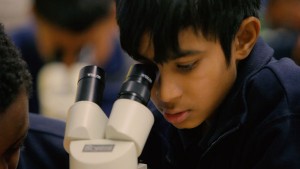CSUN Student Research Journal Celebrates 20th year of Changing Young Lives
It’s not every day that an eighth grader like Alan Mendez of Oliver Wendell Holmes Middle School says, “I want to be an experimental physicist when I grow up.” Mendez said it’s because he “wants to learn more about how matter works.”

A young student works hard at his science project. Since 1995, CSUN, under the leadership of biology professor Steven Oppenheimer, has published a journal that spotlights the work of K-12 scientists. Photo by Hailey Graves.
Mendez and his classmates last year took part in “The New Journal of Student Abstracts” created by California State University, Northridge biology professor Steven Oppenheimer, who specializes in cancer research. The journal is designed to spark the scientific imagination in K-12 students.
“The things we find most difficult in getting kids excited is finding something that’s interesting to them, something that they want to do,” said Terri Miller, Mendez’s seventh grade biology teacher at Holmes, who has participated in the journal for more than a decade. “With the journal, they are allowed to pick whatever individual project they want to do. And they are the actual scientists.”
The latest edition of the journal was published in October.
The student journal was first published in 1995 as on offshoot of lectures and workshops that CSUN was holding for science teachers. The workshops were designed to empower teachers and help them come up with creative research materials and ideas for their classrooms.
“It began to be apparent that a student journal would be the perfect way for teachers to take what they were learning and incorporate it into their students’ learning,” said Oppenheimer. “The biggest challenges that teachers face in getting students excited about science is they are so inundated with so much work, forms and tests,” he continued. “It really takes a true pioneer to do this extra work in getting the students excited about science.”
With as many as 300 students published in the 2014 issue alone, the student journal has received multiple awards and recognition. This year, the project was recognized at the White House STEM (science, technology, engineering and math) conference and by CSU Chancellor Timothy P. White.
“Clearly it is with pride that this research demonstrates not only excellence and dedication of our faculty, but also serves as an example of a program at the middle school level that gets students excited about STEM careers by engaging them in research and getting their research published,” White wrote in a letter to CSUN President Dianne F.Harrison. “The creative and scholarly pursuits of our faculty imbued in opportunities to inspire and mentor future CSU students is to be commended and replicated.”
Oppenheimer’s dreams for the journal have only just begun.
“Just in the last couple of years, this journal has been on the Web, along with every issue that we have ever published,” said Oppenheimer. “Now, anyone in the world can read it to get ideas for research, and people can also submit abstracts to the journal. So I envision the journal getting much larger coverage as people around the world begin to read it and contribute.”
Oppenheimer said the credit for the journal’s success belongs to the K-12 educators.
“It’s these great teachers who do the work, I just tell the jokes,” he said. “It’s just a pleasure working with these students, teachers and editors.”
Student projects have ranged from testing the blood pressure of those playing different video games and measuring the change in perception of time while listening to music, to what makes the most aerodynamic paper airplane.
Aphrodite Antoniou, an eighth grade science teacher at Frost Middle School who has been participating in the journal for seven years, said parents love it too. “The journal gets the parents involved in motivating the students to participate because they understand the impact it will have on the students,” she said. “Knowing that they can use the journal on their resume and application to college, the students get more excited and motivated.”
Greg Zem, a teacher at Lawrence Middle School, said the journal’s impact is long lasting.
“The journal shows them that they can publish, and makes a career in science real,” he said. “I tell them, ‘We need 100,000 new scientists in the next 10 years, and you’re it. That’s the deal: I teach the science, you go out and save the world.”
For more information or to contribute to the “The New Journal of Student Abstracts,” or view the published abstracts, please visit its website.

 experience
experience